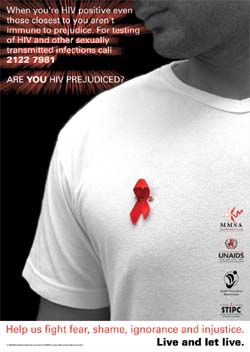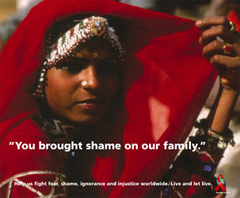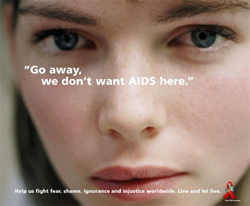|
 Three million people died of AIDS this year compared with 2.7
million last year, and five million were newly infected -- both
more than ever before, according to AIDS Epidemic Update: December
2003, compiled and published by UNAIDS, the United Nations Joint
Programme on HIV/AIDS. Forty million people are now living with
HIV, up slightly from last year. Three million people died of AIDS this year compared with 2.7
million last year, and five million were newly infected -- both
more than ever before, according to AIDS Epidemic Update: December
2003, compiled and published by UNAIDS, the United Nations Joint
Programme on HIV/AIDS. Forty million people are now living with
HIV, up slightly from last year.
There is good news from a number of individual countries, as
well as increased commitment from many governments, and
increased total resources worldwide devoted to the epidemic.
Some prevention programs have worked well. But many countries
are at a critical stage where they could abort a major epidemic
if they act now. Unfortunately some of their governments are
still not serious about AIDS.
A few situations, among hundreds of others:
Swaziland, in Southern Africa, shows how fast HIV can spread.
In 2002 almost 39% of the entire adult population age 15-49 had
HIV. Ten years before it was 4%. (Imagine what this means for
Eastern Europe, many parts of Asia, and other places where
governments are not dealing with an early epidemic that could
still be stopped, if only people mobilize in time.)
In Africa, fewer than 2% of those who need treatment now can
get it. In heavily affected countries, only about 1% of women
have access to services for prevention of mother-to-child
transmission.

In many African countries, HIV prevalence seems to be
stabilizing at a high level -- but this is not really good news.
The reason the percentage infected is not higher is that more
people are dying.
In the U.S., about half of the 40,000 new infections this year
are of African-Americans (who make up 12% of the population) --
often women who avoid high-risk behavior themselves but get HIV
from men who are secretly having risky sex or sharing needles --
just one of many illustrations of how stigma and discrimination
make AIDS control more difficult.
Successes include Kampala, Uganda (about 8% of pregnant women
now have HIV, an indicator of prevalence in the general adult
population -- a "remarkable feat" according to the report). No
other country has done as well, although big drops have also
occurred in Ethiopia and Rwanda.
"Globally, the AIDS response is moving into a new phase.
Political commitment has grown stronger, grass-roots
mobilization is becoming more dynamic, funding is increasing,
treatment programmes are shifting into gear, and prevention
efforts are being expanded." (AIDS EPIDEMIC UPDATE: DECEMBER
2003).
 Total public and private global spending on AIDS prevention,
treatment, and care is now about $4.7 billion dollars
($4,700,000,000) a year, compared to a need of $10 billion --
better than before, but scandalously low for an epidemic killing
3,000,000 people per year and likely to kill tens of millions
more.
Total public and private global spending on AIDS prevention,
treatment, and care is now about $4.7 billion dollars
($4,700,000,000) a year, compared to a need of $10 billion --
better than before, but scandalously low for an epidemic killing
3,000,000 people per year and likely to kill tens of millions
more.
As programs scale up, another critical shortage is trained
personnel. HIV treatment is needed now to keep medical and other
trained people alive. Also, despite critical shortages,
thousands of nurses in Africa are now unemployed due to caps on
spending for public services.
Facts like these hint at what individuals and organizations can
do. Many of the problems are local, and can only be handled by
those directly involved. But many others (especially the lack of
resources) are global. And many problems in the developing world
originate in the U.S. and other rich countries.
AIDS Treatment
News
Published twice monthly
Subscription and Editorial Office:
1233 Locust St., 5th
floor
Philadelphia, PA 19107
800/TREAT-1-2 toll-free
email:
aidsnews@critpath.org
useful
links: http://www.aidsnews.org/
Editor and Publisher: John S. James
Associate
Editor: Tadd T. Tobias
Statement of Purpose:
AIDS Treatment News reports on experimental and
standard treatments, especially those available now. We interview
physicians, scientists, other health professionals, and persons with AIDS
or HIV; we also collect information from meetings and conferences, medical
journals, and computer databases. Long-term survivors have usually tried
many different treatments, and found combinations that work for them.
AIDS Treatment News does not recommend particular therapies,
but seeks to increase the options available.
AIDS Treatment News is published 24 times per year,
on the first and third Friday of every month, and print copies are sent by
first class mail. Email is available (see below). Back issues are
available at http://www.aidsnews.org/
To subscribe, you can call 800-TREAT-1-2 or 415-255-0588:
Businesses, Institutions, Professionals: $325/year. Early email
available (see below).
Nonprofit organizations: $150/year.
Individuals: $140/year, or $80 for six months. If you cannot afford a
subscription, please write or call about our sliding scale.
Outside North, Central, or South America, add airmail postage:
$20/year, $10 for six months.
Bulk rates and multiple discount subscriptions are available; contact
our office for details.
Payment can be by check, VISA, Mastercard, American Express, bank
draft, purchase order, international postal money order, or travelers
checks.
Early email: Business, nonprofit and full-rate individual
subscribers can receive an early copy by email, before the issue is
printed--in addition to their regular copy, at no extra charge. It's OK to
direct the email copy to someone else. Call our office to add email to
your subscription.
Free email: Free delivery for individuals (delayed one
week). To subscribe, send a blank email to: aidsnews-subscribe@egroups.com
ISSN # 1052-4207
Copyright 2003 by John S. James.
|
|
|

 Three million people died of AIDS this year compared with 2.7
million last year, and five million were newly infected -- both
more than ever before, according to AIDS Epidemic Update: December
2003, compiled and published by UNAIDS, the United Nations Joint
Programme on HIV/AIDS. Forty million people are now living with
HIV, up slightly from last year.
Three million people died of AIDS this year compared with 2.7
million last year, and five million were newly infected -- both
more than ever before, according to AIDS Epidemic Update: December
2003, compiled and published by UNAIDS, the United Nations Joint
Programme on HIV/AIDS. Forty million people are now living with
HIV, up slightly from last year.
 Total public and private global spending on AIDS prevention,
treatment, and care is now about $4.7 billion dollars
($4,700,000,000) a year, compared to a need of $10 billion --
better than before, but scandalously low for an epidemic killing
3,000,000 people per year and likely to kill tens of millions
more.
Total public and private global spending on AIDS prevention,
treatment, and care is now about $4.7 billion dollars
($4,700,000,000) a year, compared to a need of $10 billion --
better than before, but scandalously low for an epidemic killing
3,000,000 people per year and likely to kill tens of millions
more.
